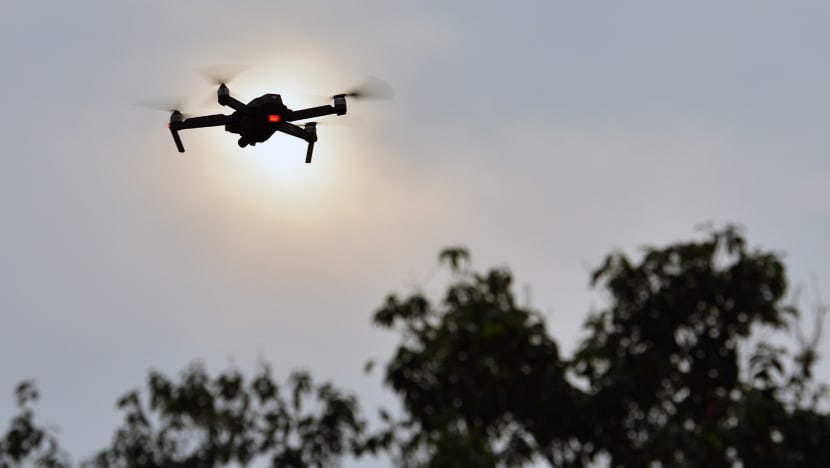Drone disruptions at airports: How dangerous are they to aircraft?

File photo of a remote controlled drone hovering in the air (Photo: Jeremy Long)
SINGAPORE: Drone sightings have disrupted flights at Singapore's Changi Airport for the second time in a week, with around 18 departure and arrival flights delayed on Monday night (Jun 24).
Seven flights were diverted, said the Civil Aviation Authority of Singapore (CAAS).
A similar incident involving unauthorised drone flying affected 38 flights on Tuesday and Wednesday last week.
With drones increasingly disrupting operations at airports around the world, just how dangerous are they to aircraft and can more be done to tackle the issue?
RISK OF MID-AIR COLLISIONS
The greatest danger posed by drones flying near airports is the possibility of mid-air collisions with aircraft, said Dr Foong Shaohui, an associate professor at the Singapore University of Technology and Design. His specialisation includes unmanned aerial vehicles or drones.
“Any contact between drones and aircraft, especially critical areas such as the engine, can be very dangerous to the aircraft,” he said. “This is similar to bird strikes where aircraft can sometimes hit birds and they get ingested into the engine.”
Due to the sheer speed of aircraft, the damage could be significant.
"If any of these drones strike the aircraft, it can actually puncture the wings, it can get sucked into these engines, causing the engines to shut down. So all of these will cause a loss of control to the aircraft itself, and the effect will be catastrophic," said Associate Professor Paw Yew Chai from the Engineering Cluster at the Singapore Institute of Technology.
Drones may also hit vital parts such as the antennae and air speed sensors.
According to Garuda Robotics CEO and co-founder Mark Yong, there could be potential injury and property damage on the ground from falling objects.
WHAT ARE THE CHANCES OF A COLLISION?
The difference in operating altitudes of aircraft and drones means that the risk of collision is "low", said Mr Zhang Weiliang, CEO of drone solutions company Avetics Global.
"Moreover, for DJI drones, there is a built in geofence system that prevents the drone from going near airports," he added.
"That said, because the speed of the plane is fast, it is very hard to have any sort of evasive actions by the plane."
READ: Eagles, lasers and nets: Options for dealing with rogue drone flights
GEOFENCING SYSTEMS
Most commercial drones have build-in safety systems known as geofencing to prevent unauthorised entry.
"When powered on in a restricted airspace (near an airport), the drone will enter a safety mode which will prevent the drone from flying. And if the drone is flying in an unrestricted area and approaches a restricted area, its internal software will prevent the drone from flying into the restricted area," said Dr Foong.
According to the website of leading drone maker DJI, it sets up "Geo Zones" around airports, and provides users with "up-to-date" guidance on areas where drone flight may be limited due to safety concerns or regulations.
HOW IS IT POSSIBLE TO FLY DRONES INTO RESTRICTED AREAS?
It is, however, still possible to fly drones into restricted areas - if the devices do not have geofencing systems.
"One way is that the drone operator might have geobreak the drones to allow the drone to operate within this sort of geofence area," explained Dr Paw.
"The other thing is not all of the drones have this feature of geofencing. Those drones that don’t have all these geofencing feature can still take off and fly within geofence area," he said, adding that there are also users who build their own drones without these systems.
STIFFER PENALTIES NEEDED, SAYS EXPERT
Singapore law prohibits drones from flying within 5km of an airport without a permit. Offenders could face a jail term of up to 12 months and a fine of up to S$20,000.
But Dr Paw suggested that stiffer penalties and more regulations are needed to address the issue of unauthorised drone flying.
"Maybe we can have more sophisticated means of doing counter-measurements such as, you might need the drone to get registered so that we can have proper regulation and we can actually track the drones, where they go," he said.
READ: Most drone operators fully aware of restrictions around Changi Airport, say hobbyists
Observers agree that there is some education on the part of CAAS and drone retailers on no-fly zones, but the recent sightings at the vicinity of Changi Airport show that regulators and the industry must continue work to address the issue.
Said Garuda Robotics' Mr Yong: "With the number of drones in the air expected to be many times the number of manned aircraft, it is critical for the drone industry and regulators in Singapore to continue working together to refining technology and regulations to ensure safety is maintained."












